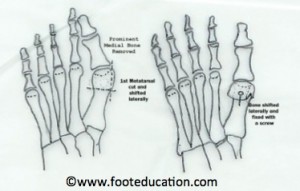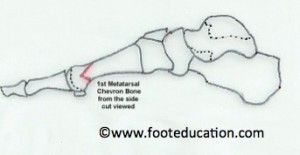Chevron Osteotomy (Distal) for Hallux Vallgus (Bunion)
Edited by Anthony Van Bergeyk, MD
Indications
A Chevron osteotomy is indicated for correction of a mild to moderate hallux valgus deformity. This allows for a small reduction of the angle between the first and second metatarsal. It is ideal for bunions that are not particularly pronounced.
Procedure
The procedure involves a V-shaped cut in the distal aspect of the first metatarsal, near the metatarsal head (See Figure 1). This allows the distal aspect of the bone to be translated between 45 mm in the lateral direction (See Figure 2). The cut bone is then fixed in this position with a small screw or a suture of some sort. The excess bone on the inside of the foot (medial side) is then resected. The joint capsule is also tightened to allow for correction of the bunion.
Figure 1: V-shaped cut in the distal aspect of the first metatarsal
Figure 2:

Recovery Time
Patients undergoing a chevron osteotomy are often allowed to walk, as long as they are in a stiff soled shoe and they mostly walk with weight through their heel. Some surgeons limit patients walking for a few weeks after this procedure. They do need to limit their activity in the postoperative period, as excessive activity can lead to a nonunion or a malunion. Patients can usually be advanced to a more normal shoe at 6 weeks. However, it will often be 3-4 months before they have made 80% of their recovery, and often 9-12 months before their maximal recovery is achieved. Patients recovering from a chevron osteotomy (or other foot surgeries) can have persistent swelling. This can carry on for a number of months following surgery. This is due to increased blood flow as part of the healing process.
Potential Complications
The usual list of general post-surgical complications may occur with a Chevron osteotomy. This includes the potential for:
- Wound healing Problems
- Infection
- Nonunion
- Local nerve injury
- Deep Vein Thrombosis (DVT)
- Pulmonary Embolism (PE)
Specific Complications
Complications that are specific to Chevron osteotomy include:
- Malunion: This can occur when the bone either is not positioned correctly resulting in abnormal position of the toe, or when the position of the osteotomy changes following surgery. In this instance, the toe may be malpositioned even to the point where further surgery is required.
- Painful Hardware: Hardware (screws) may loosen or hurt after surgery – this may require additional surgery to remove.
- Avascular necrosis of the metatarsal head: This occurs when there is a loss of blood supply to the metatarsal head. Fortunately, this is relatively uncommon, occurring in less than 3% of patients. Incisions on both sides of the toe can increase the chance of this happening.
- Recurrence of the Deformity: Other complications include failure to fully correct the bunion deformity or the potential for recurrence of the bunion over time.
- Hallux Varus: Excessive release of the lateral (outside) capsule of the MTP joint can lead to hallux varus. This is a deformity that can be difficult to correct.
Previously edited by Mark Perry, MD
Edited September 29, 2019
mf/ 11.19.18
